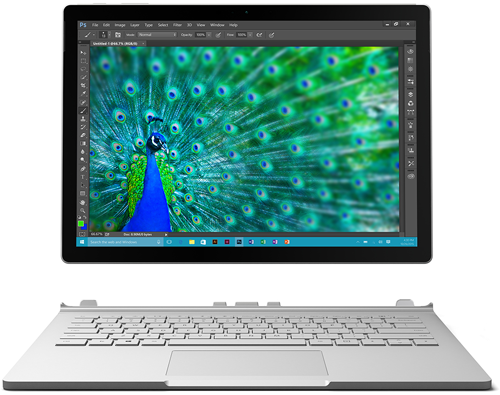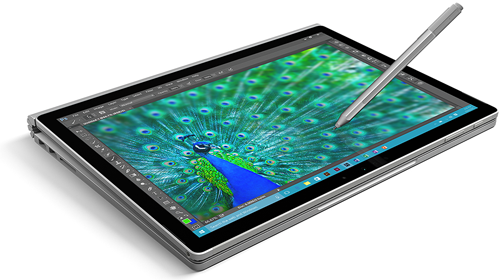Hands-On with the Microsoft Surface Book
The Microsoft Surface Book is the first covet-worthy laptop of the Windows 10 era.
Microsoft's inaugural first-party hardware entry in the crowded laptop market hit general availability on Monday. I spent an hour Monday morning at the Microsoft Store in Arlington, Va., getting a hands-on demo of the Surface Book and the new Surface Pro 4. (Click here for the Surface Pro 4 article.)
The first thing you notice is the hinge. Microsoft calls it a dynamic fulcrum hinge, and the parts move to expand the hinge as the laptop opens. Closed, this laptop doesn't fold flat like almost every other notebook. Instead, it makes a wedge shape, which is wider at the hinge end. Some reviewers are concerned that the hinge makes the keyboard and screen more likely to collect dust and dirt when not in use. Still, the toothlike edges of the hinge give the closed Surface Book a snarling quality, like it's waiting impatiently for you to come back and let it spring into action.

That wild hinge isn't an extravagance -- it's a functional form designed to allow the screen to come off and become a tablet. As such, the quality is critical. Time will tell, but the hinge looks and feels like it's built to last.
Unlike some other 2-in-1 attempts at removable screens, the Surface Book has a keyboard button along the top row that releases the screen. A long press results in a green light on the key when the tablet is unlocked from the hinge. It slips out seamlessly. Reconnecting the tablet provides an onscreen prompt that it has been securely reattached. At that point, you can grab the screen and shake or grab the keyboard and shake. The connection is rock-solid.

Removed from the keyboard, the tablet itself feels nicely balanced and ridiculously lightweight for its large size (it's a 13.5-inch display). Technically, Microsoft calls the tablet a clipboard because of the magnetic pen attached to the top. Microsoft works its lightweight magic by putting the graphics processor and the bulk of the battery in the keyboard. Used as a laptop with the keyboard battery, the device is good for 12 hours of video playback, according to Microsoft. In clipboard mode, the tablet part is supposed to have about three hours of standalone battery life.
Reattaching the keyboard facing backward opens up a few more usage modes, including a folded shut mode for drawing.

As a laptop, the device is less than 3.34 pounds. Using it on your lap is a big improvement over trying to balance a Surface Pro-and-keyboard assembly, but the real parallel here is that it's the same as any other lightweight laptop.
Despite having the CPU, RAM and storage up behind the screen, the counterweight of the graphics processor and battery in the keyboard make for a balanced system. Pushing on the top of the screen doesn't tip the Surface Book over on its back.
The keyboard itself is a selling point. Microsoft engineers focused on the typing experience, emphasizing things like "travel" in the keys. I'm not sure what that means, but the keyboard was a joy to use. Microsoft may be a relative newcomer to PC manufacturing, but it's been making keyboards for decades. Some of the biggest innovations on the Surface and Surface Pro tablet lines have been in the keyboard, and the same thought and quality has gone into the Surface Book's keyboard, too.
From the hinge to the magnesium casing with its silver Microsoft logo, this is one attractive and powerful business machine. The biggest questions revolve around whether Microsoft's laptop is worth it.
From a buyer's perspective, it boils down to the price, and whether it's worth it for that individual's circumstance. The Surface Book runs from $1,499 for a 128GB, Core Intel i5 model with 8GB of RAM to $3,199 for a 1TB, Core Intel i7 with 16GB of RAM, a high price range for a business laptop.
From an industry standpoint, there's an open question as to whether the payoff will be high enough for Microsoft to justify having released this product. After all, Microsoft plays a deep game -- offering first-party products that it hopes will sell well but that it also hopes will inspire its OEM partners.
Back when Microsoft launched the original Surface, several OEMs were angry. They hadn't gotten a heads up that Microsoft was getting into hardware. Fast-forward a few years and the results are looking pretty good for Redmond. HP and Dell are reselling the Surface Pro, and the productivity tablet is spawning direct copycat models in the VAIO Canvas and the Lenovo Miix 700 and an indirect copycat model in the Apple iPad Pro.
With the Surface Pro, though, Microsoft was launching a new category of device and was willing to shell out a few billion dollars in the effort when OEMs partners weren't investing there on their own. The Surface Book isn't creating a new category. It's improving on a category OEMs have been delivering on since Windows 8 launched.
For argument's sake, let's call the Surface Book a 5 or 10 percent improvement on the next best 2-in-1 laptop.
Even if this is "the ultimate laptop," as Microsoft's Surface architect Panos Panay said repeatedly in unveiling the Surface Book, it's an incremental ultimate laptop, not a revolutionary one. It's hard to see the Surface Book spurring on Microsoft's OEM partners, as the Surface Pro did, so much as just making them grumble.
Posted by Scott Bekker on October 26, 2015